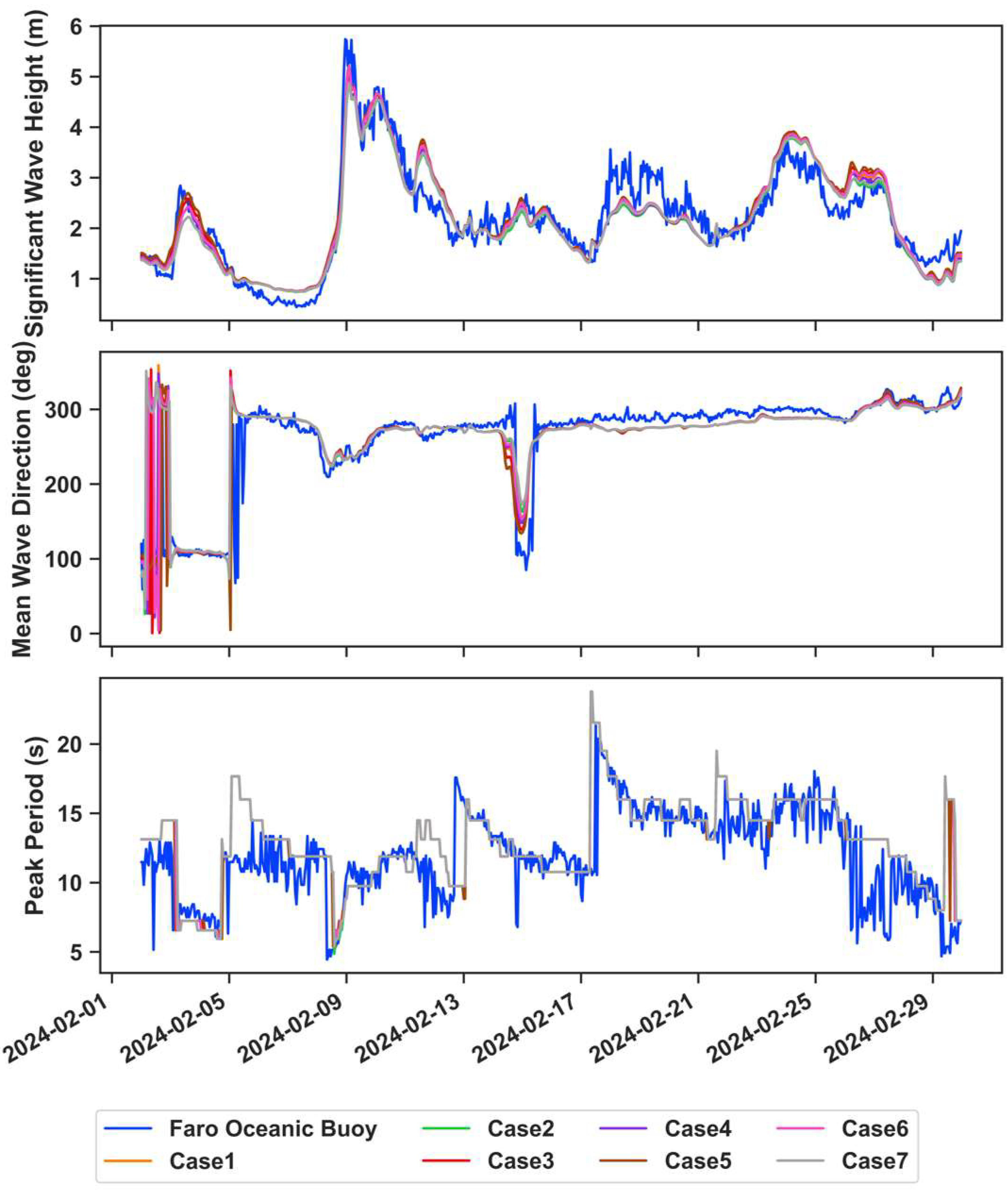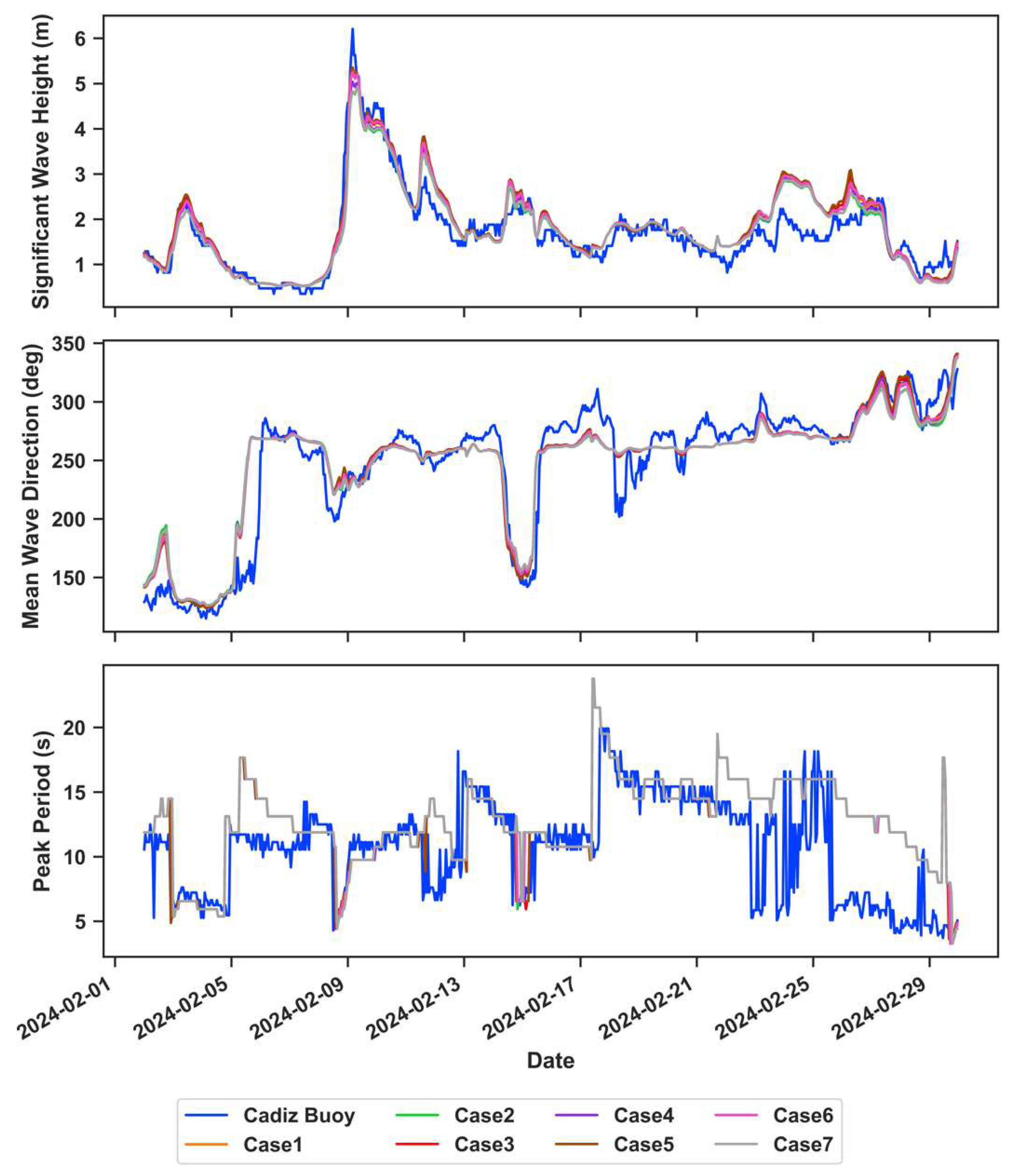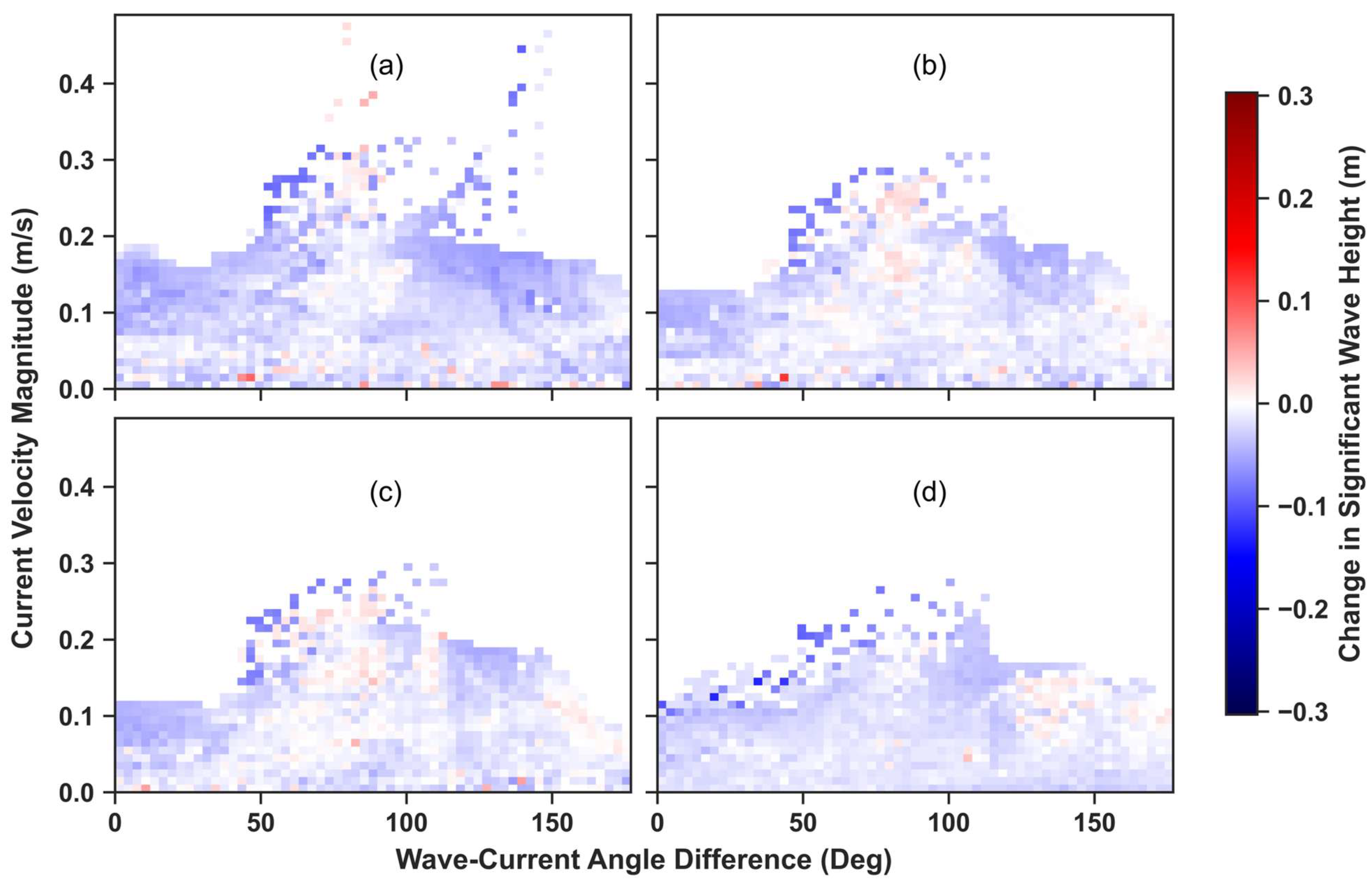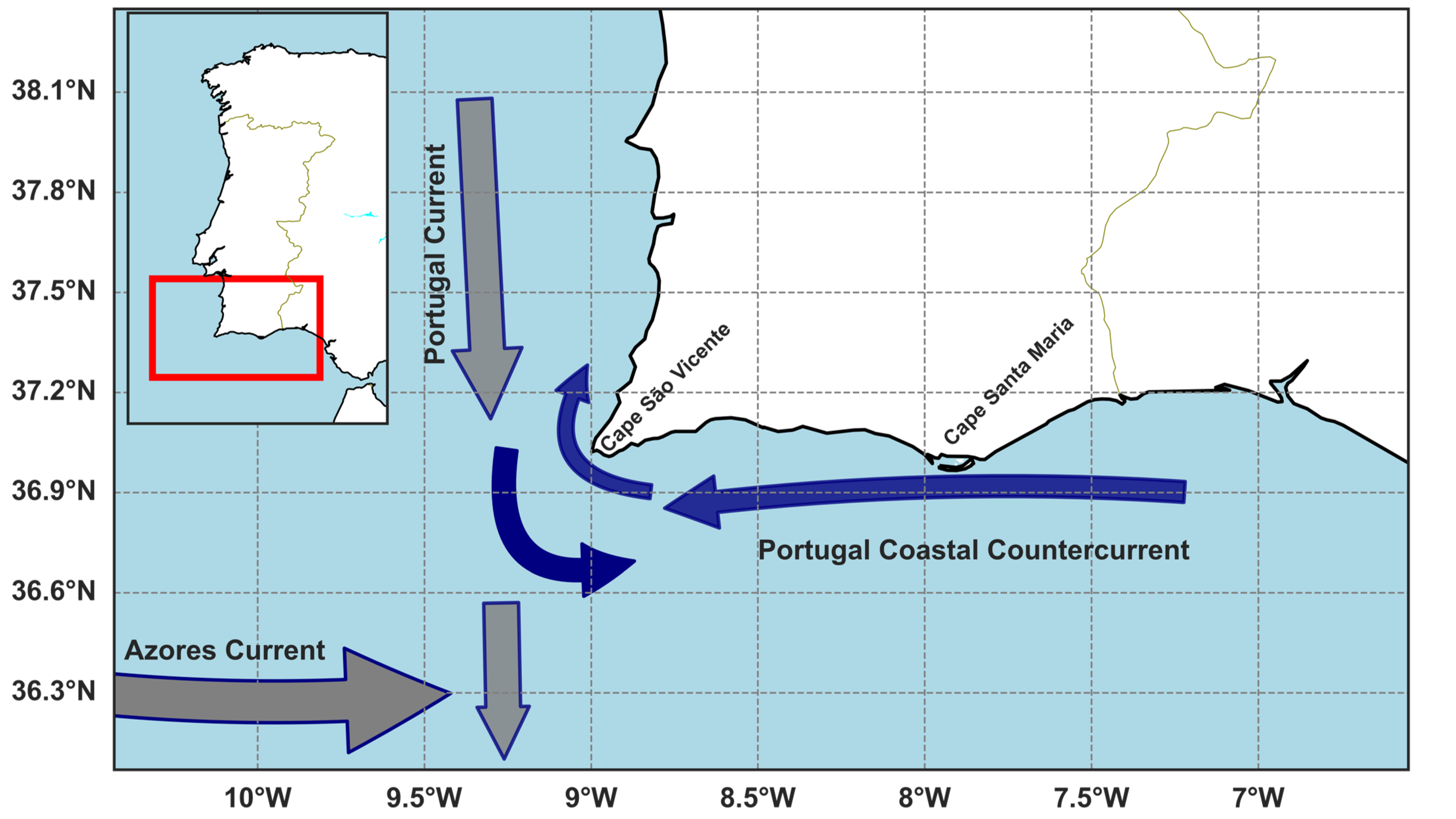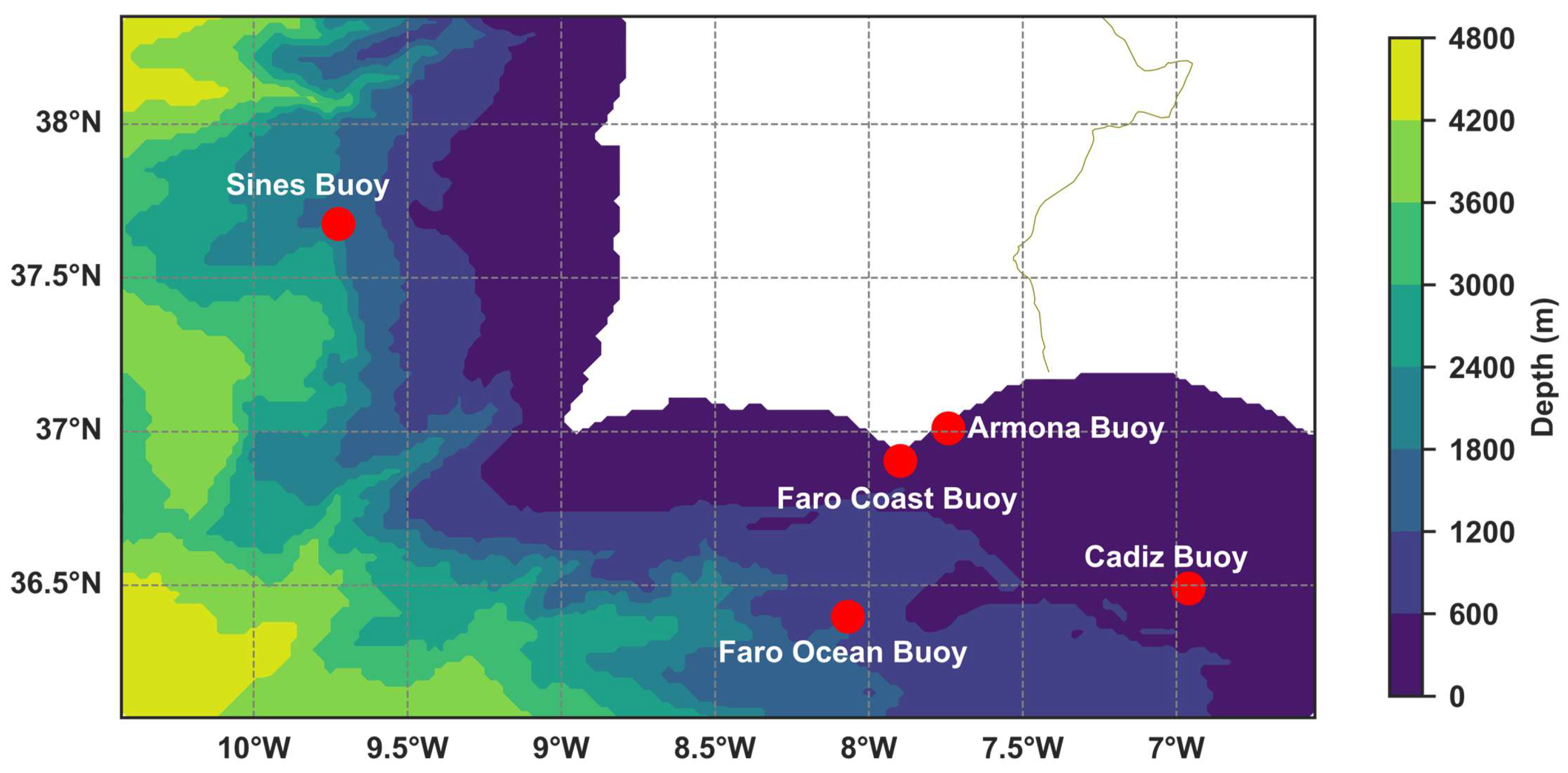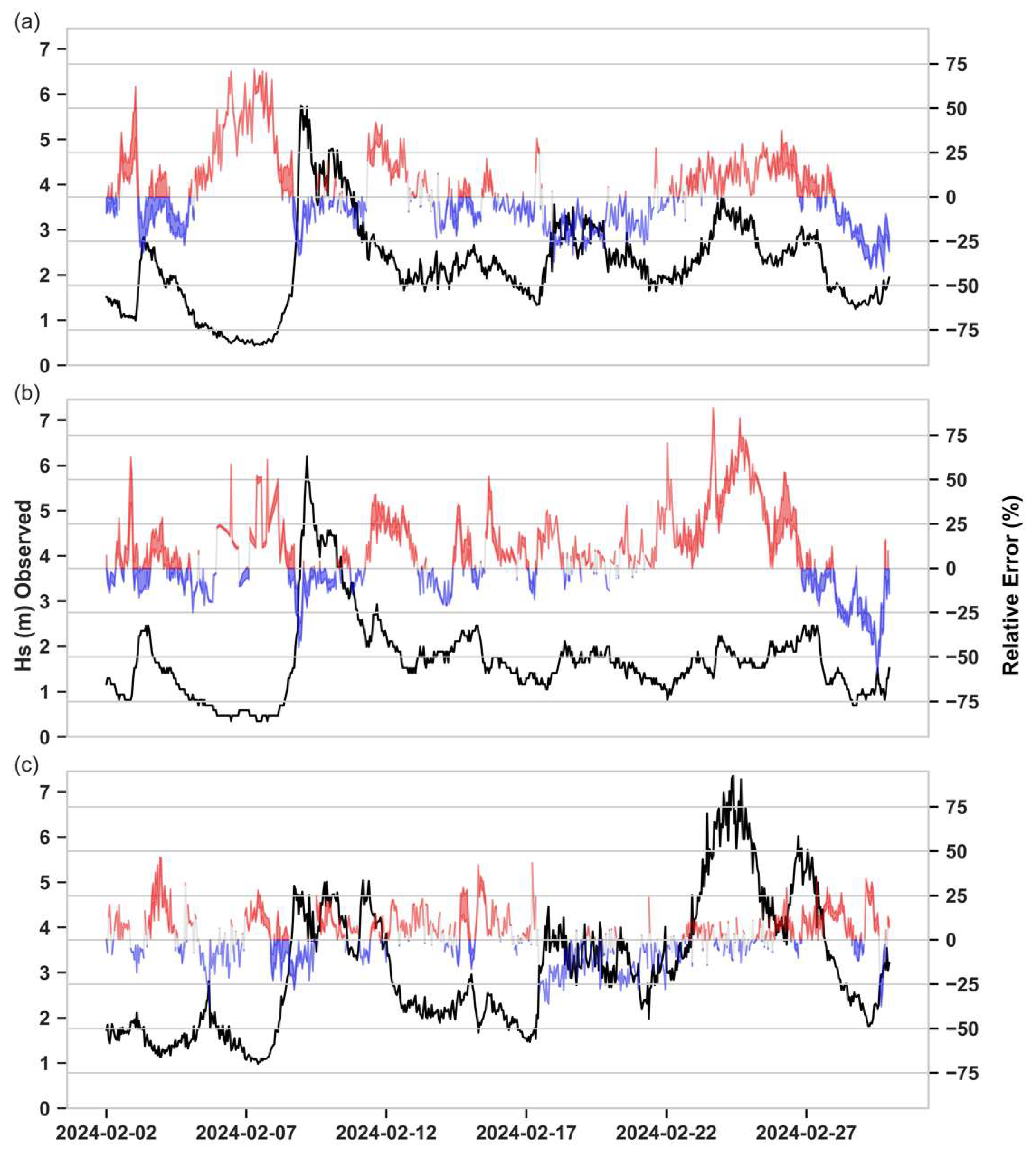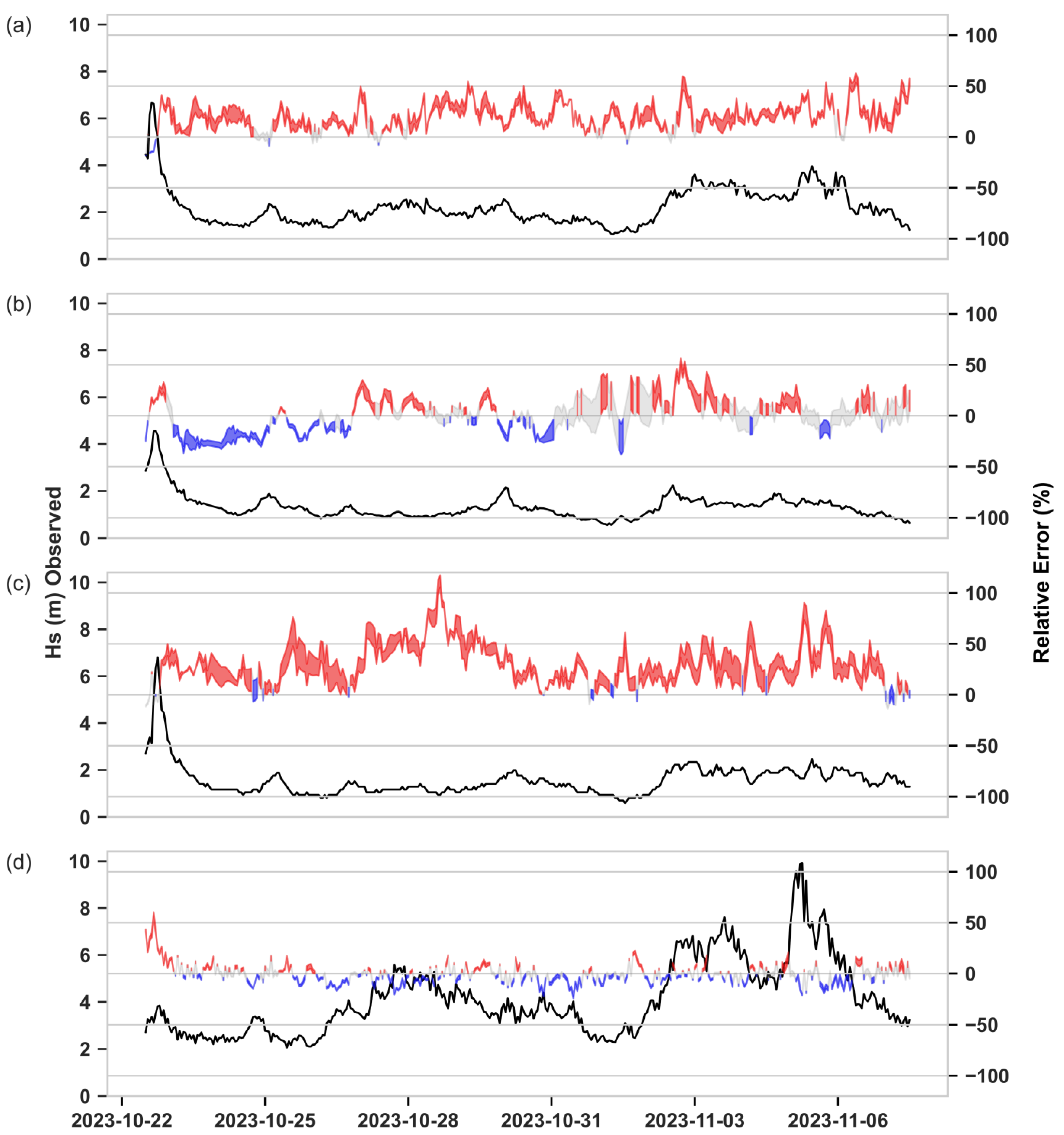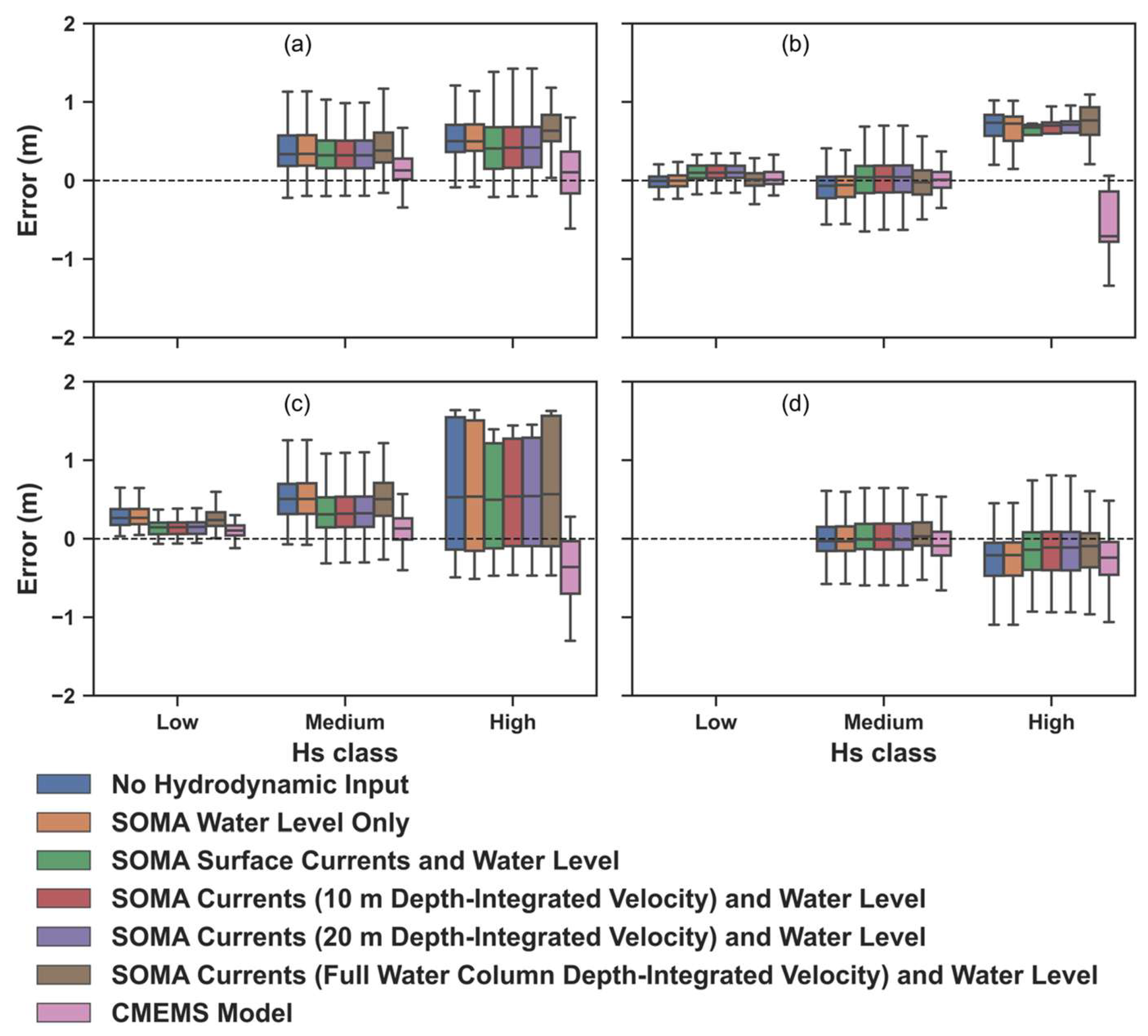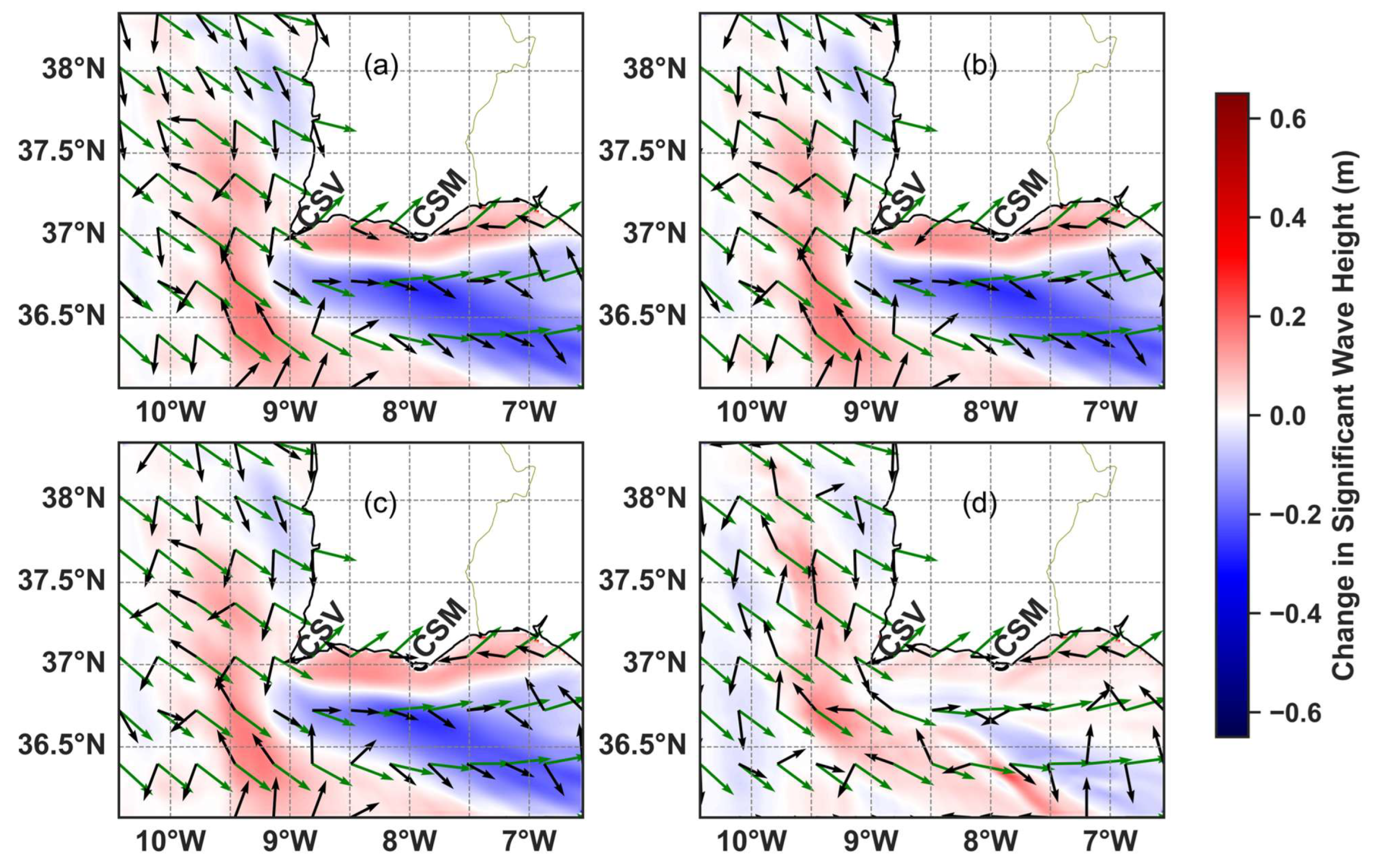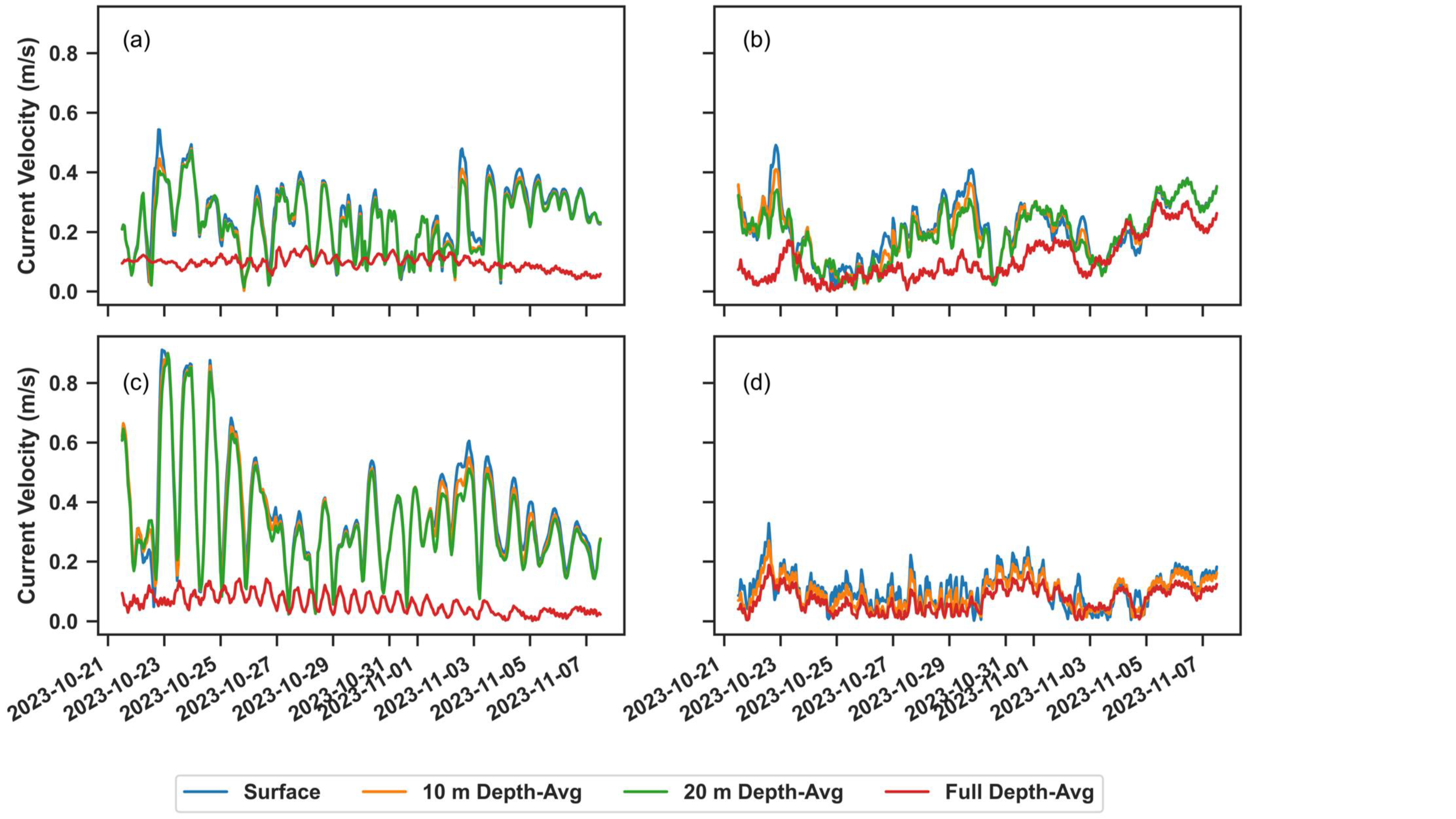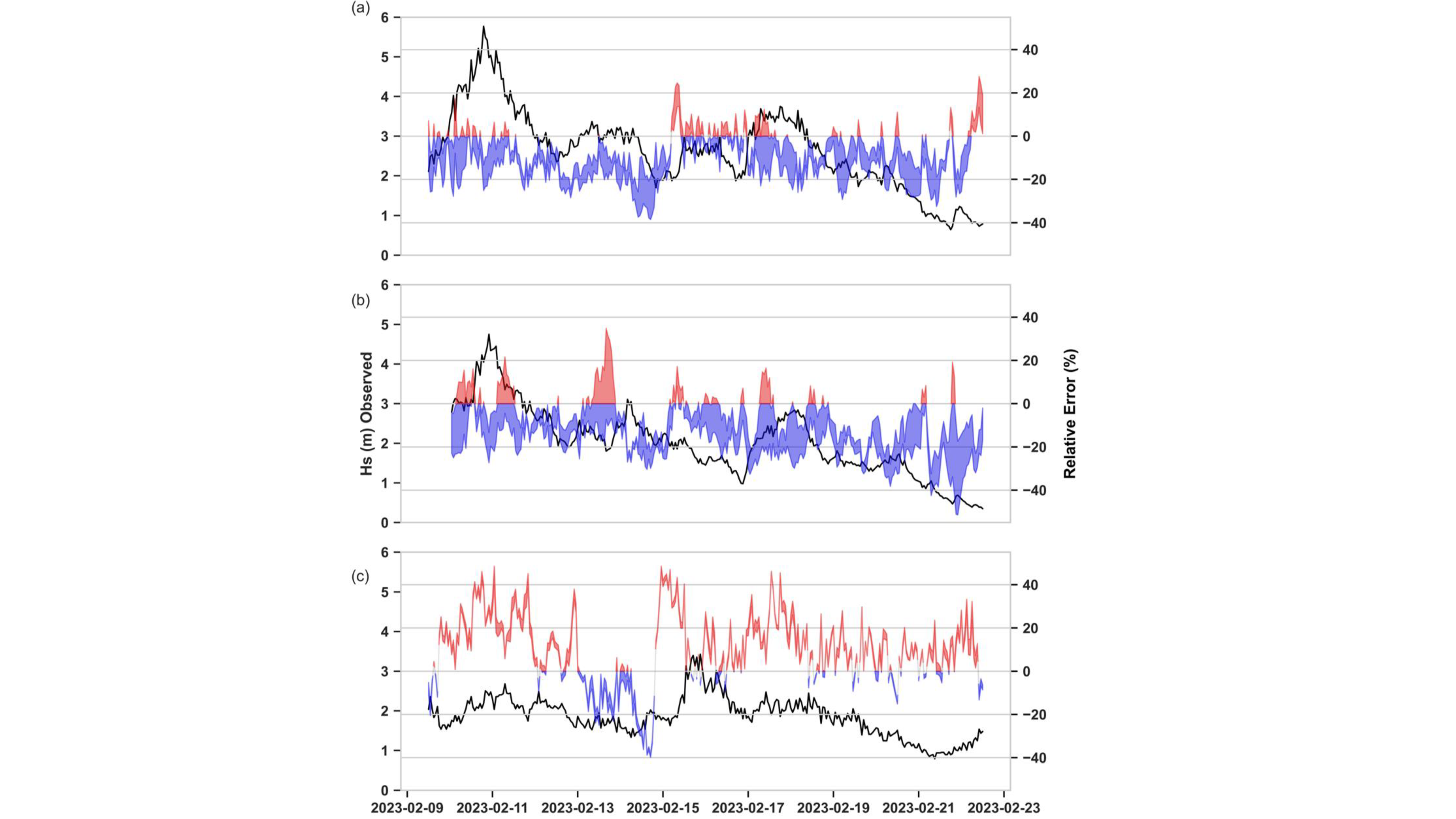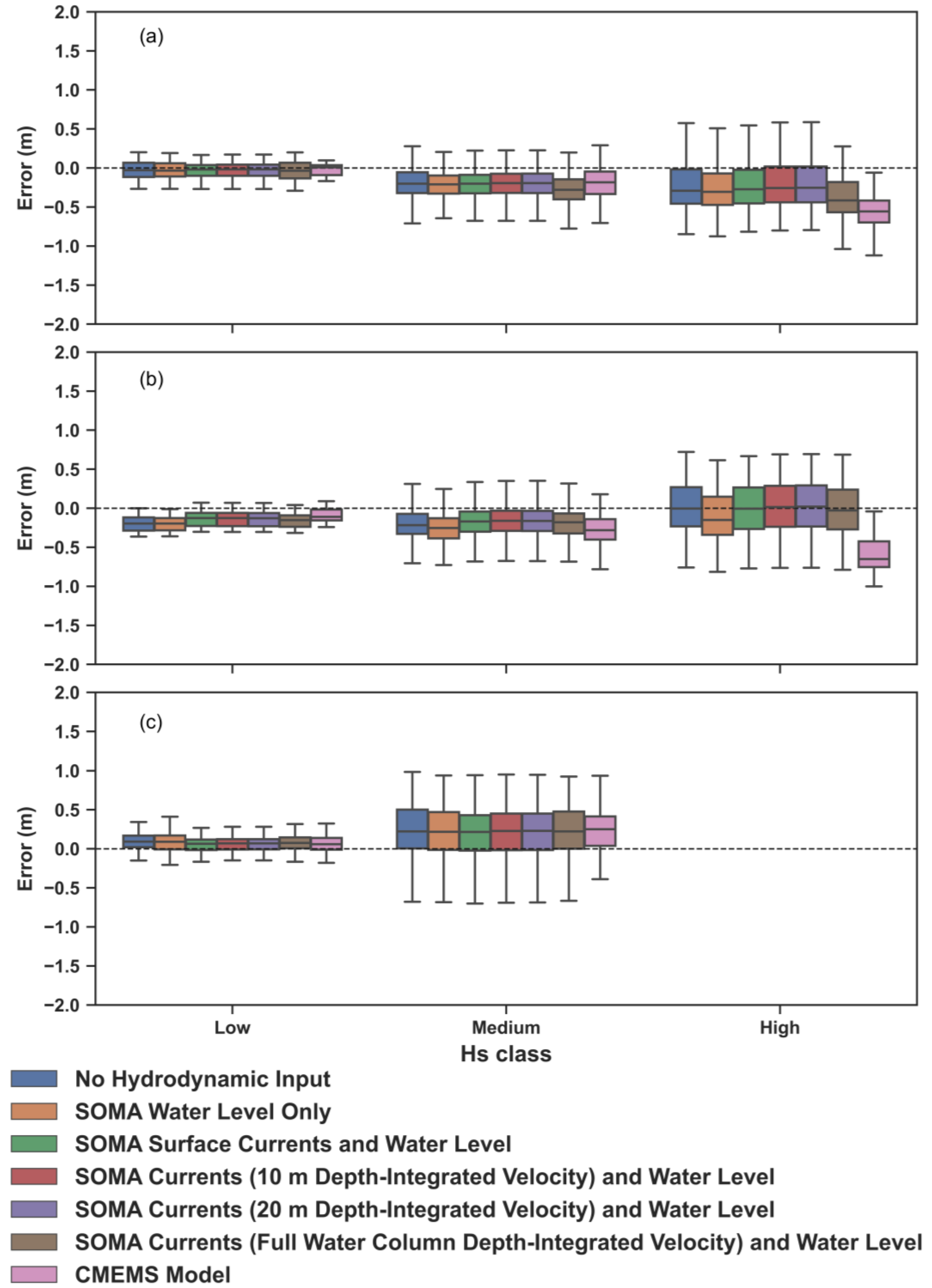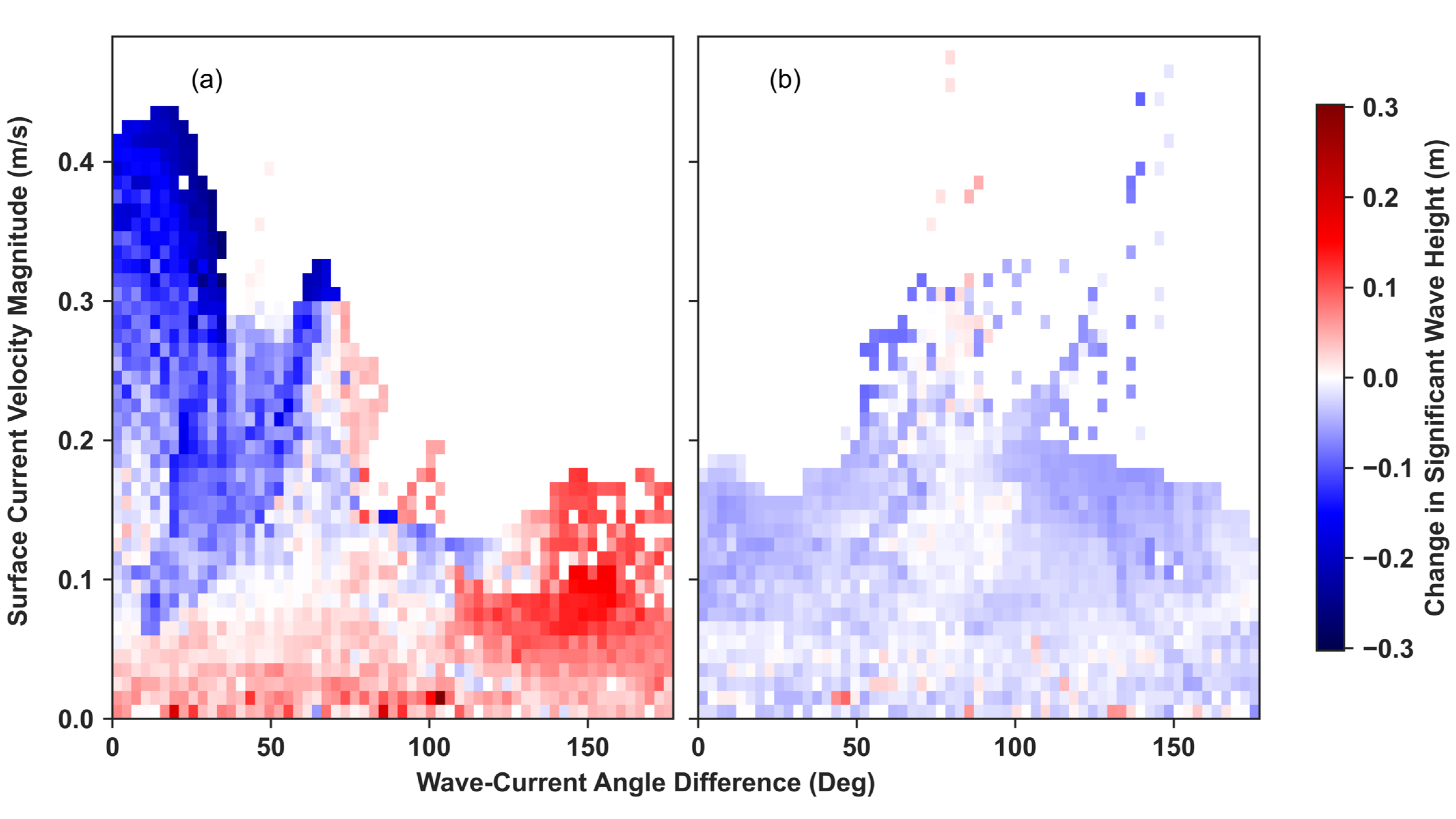3.3.1. Waves Coming from the W-SW
To assess the influences of the various hydrodynamic inputs on wave propagation during a storm with predominantly W-SW waves, a time series of the significant wave height is exhibited in
Figure 5. Buoy observations are shown on the left axis, while the range in the relative error between all the modeled results (run IDs from
Table 4) and buoy observations are plotted on the right. This allows for an analysis of model’s ability to accurately capture wave propagation throughout the simulation and to assess the variability between the model runs that implemented various hydrodynamic forcings.
In general, it can be stated that when Hs was high (above ~3 m), all the models underpredicted Hs (
Figure 5). Off the south coast, the peak of the storm occurred on 22 October 2023, as shown by the results of the Faro Ocean Buoy, Faro Coast Buoy, and Cadiz Buoy (
Figure 5a–c). At the Faro Ocean Buoy and Cadiz Buoy (
Figure 5a,c), all the models underpredicted Hs for these peaks but then tended to overpredict Hs for the remainder of the simulation. However, at the Faro Coast Buoy (
Figure 5b), all the models overpredicted Hs during the highest peak, with some models overpredicting Hs by nearly 1 m, with a relative error of approximately 20%. At the Cadiz Buoy, a relative error of 100% is observed during low wave conditions on 29 October 2023. At this time, the measured Hs was 0.5 m, while model predictions overestimated it at 1 m. Although this error seems to be high, the absolute difference is small and within a reasonable range. The Faro Coast Buoy and Sines Buoy yielded model results most similar to observations. At the Faro Coast Buoy, Hs stayed relatively low throughout the simulation, with values ranging between 0 and 2 m. Hs reached the highest off the west coast at the Sines Buoy, with values reaching nearly 10 m on 5 November 2023. The models were not able to capture this extreme wave height. However, they matched the observations quite well during the simulation and tended to overestimate Hs when Hs was low and underestimate Hs for higher values. In terms of the variance between the model results,
Figure 5 shows more variability at the Faro Coast (
Figure 5b) and Cadiz (
Figure 5c) toward the end of the simulation, when Hs was low. The largest variability between the models in the relative error at these two locations was 37.71% and 29.84%, respectively. The smallest variability between the models is seen at the Sines Buoy (
Figure 5d), with a maximum variance between the relative error of the models of 7.51%.
To summarize these errors during the simulation, boxplots were created showing the error in Hs (m) between each modeled simulation and the observed values according to the Hs class. On one hand, in the Gulf of Cadiz (Faro Ocean, Faro Coast, and Cadiz), Hs classes were defined as low (0–1 m), medium (1–3 m), and high (greater than 3 m). On the other hand, off the west coast of the Iberian Peninsula (Sines), the threshold for high waves is greater than 4 m [
69].
The boxplots of the W-SW in
Figure 6 demonstrate the model’s tendency to overpredict Hs (error > 0) across all the simulations. At the Faro Ocean Buoy, the runs with no hydrodynamic input, SOMA water level only, and depth-averaged velocity of the entire water column demonstrate larger errors compared to those of the runs incorporating the current velocity from the upper layers of the water column. The CMEMS model produced lower errors compared to all the modeled runs at this location. At the Faro Coast Buoy, the runs incorporating the current velocity from the upper layers of the water column produced higher errors under low and medium wave conditions. However, in high wave conditions, the runs incorporating the SOMA current velocity from the upper layers of the water column performed better. At this location, the median error across all the simulations is 0, with all the models both slightly overpredicting and slightly underpredicting Hs. The error produced by CMEMS at this location was low for low and medium waves but high for high wave conditions, with significant underpredictions in Hs. At the Cadiz Buoy, the distribution in the error for all the models was quite high for the high-Hs class. The time series in
Figure 5 demonstrate that this condition occurred during the peak of the storm on 22 October 2023, when the range in the relative error for all the models ranged between approximately −10% and 50%. The errors at Sines were small for all the simulations, with the median error being very close to 0 for all the model runs when waves were between 1 and 4 m. Under higher wave conditions (above 4 m), the models tended to underpredict Hs, which is also apparent in the time series in
Figure 5.
To quantify the error more precisely between specific model runs and observations,
Table 7 presents the metrics of RMSE, BIAS, MSS, and R. The run IDs are referenced in
Table 4. The best metric values (the lowest values of RMSE and BIAS and highest values of MSS and R) among all the simulations are highlighted in bold.
Table 7 demonstrates small variability in the statistics metrics between uncoupled runs and runs that implemented the different hydrodynamic forcings from SOMA. RMSE and BIAS values stayed quite low, ranging from 0.242 m to 0.594 m and from 0.005 to 0.502, respectively. MSS and Pearson’s Correlation Coefficient were high, ranging from 0.862 to 0.982 and from 0.923 and 0.968, respectively. When comparing the SWAN runs that implemented varying hydrodynamic forcings from SOMA, Run 3 (SOMA Surface Currents and Water Level) performed better than all the other simulations by achieving the highest number of “best” metric values for all the buoys. At the Faro Coast Buoy, the run with the SOMA water level only (Run 2) performed very well, with an RMSE of 0.242 m and an MSS of 0.958. This result is consistent with Wang and Elahi’s [
16] finding that water levels play a more significant role in the modulation of the significant wave height in shallower waters, whereas the current velocity has more influence on wave propagation in the deep ocean. In comparison to the control run of the study without any hydrodynamic forcing (Run 1), all the simulations performed better, implying that adding hydrodynamic forcing improves the results. At the Faro Ocean Buoy, the RMSE was reduced by 0.054 m, or approximately 10%, when the surface currents and water level were implemented in the model (Run 3). The RMSE was reduced by 0.004 m at the Faro Coast Buoy with the case of the SOMA water level only. At this buoy location, the other runs produced less accurate results. At the Cadiz Buoy, the RMSE was reduced by 0.164 m (~28%) in the run with the SOMA surface currents and water level. In Sines, this same run reduced the RMSE by 0.029 m. Overall, the metrics presented in
Table 7 reveal improvements to the model with the addition of hydrodynamic forcing, particularly in the case of the surface currents and water level.
Table 7 shows better performance from the CMEMS model at all the buoy locations for the simulation with westerly waves. This can be due to the fact that CMEMS assimilates wave data from satellite results, leading to a more accurate representation of the model’s wave field [
49].
To test how statistically significant the modeled runs incorporating hydrodynamic forcing from SOMA were compared to the run without SOMA input,
Table 8 presents results of the DM statistic along with the
p-value across all the buoy locations.
Table 8 demonstrates that on average, across all the locations, modeled runs that surpassed the DM threshold of 1.96 were the run with the SOMA surface currents and water level, SOMA depth-averaged velocity for the upper 10 m of the water column, and SOMA depth-averaged velocity for the upper 20 m of the water column (Runs 3–5), with DM values of 6.911, 6.810, and 6.844, respectively. The CMEMS model also achieved a DM score of above 1.96, with a value of 5.789. This indicates that on average, these four modeled results are statistically significant and performed better than the baseline run without SOMA input. The mean DM across all the locations was highest for Run 3, which further supports the conclusion that model runs forced with the SOMA surface current velocity and water level yielded the highest improvement from the run without SOMA input during the W-SW storm. The runs of the SOMA water level only (Run 2) and depth-averaged velocity from the entire water column (Run 6) achieved a DM statistic of 0.426 and −0.339, respectively, and were therefore not statistically different from the run without SOMA input. In terms of the spatial variability, DM values varied slightly across buoy locations, with slightly worse, but not statistically significant, performance at the Faro Coast Buoy for the runs incorporating SOMA currents from the upper layers of the water column (Runs 3, 4, and 5), with values of −1.344, −1.751, and −1.711, respectively. Locations further offshore (Faro Ocean, Cadiz, and Sines) resulted in improved performance from these runs.
Across all the locations, the
p-value is quite low, with values much lower than the threshold of 0.05, except at Faro Coast and Cadiz. This result coincides with the statistics presented in
Table 7, which demonstrated that the RMSE did not differ significantly across model runs at these locations. For an overall summary of the
p-values across all the locations, a combined method from Fisher [
70] was performed for all the model runs. The overall results of the DM analysis for the W-SW storm demonstrate that runs forced with current velocity from the uppermost layers of the water column were the most statistically significant compared to the run without hydrodynamic forcing.
For a visual representation of how wave propagation in the computational domain changed due to the addition of hydrodynamic forcing,
Figure 7 shows spatial maps of the difference in Hs between each simulation and the simulation without hydrodynamic forcing during the westerly storm. The 2D maps represent the average difference in Hs during the westerly storm period, with overlaying velocity vectors representing the average current velocity direction as well as the mean wave direction during the storm. For a complete evaluation of the magnitude of the current velocity over time, the time series of the current velocities at four locations within the domain are shown in
Figure 8.
The magnitude of the change in Hs for each simulation, as shown in
Figure 7, was very similar for the simulations forced with SOMA surface currents, SOMA 10 m depth-averaged velocity, and SOMA 20 m depth-averaged velocity, whereas the change in Hs for the simulation forced with depth-averaged velocity for the full water column was much smaller. The change in Hs was the highest for the simulation forced with surface currents (
Figure 7a) and then reduced slightly as the depth increased, as shown from
Figure 7ba–d. This is consistent with the time series of the velocity, as shown in
Figure 8, as the magnitude of the depth-averaged velocity of the entire water column was always smaller compared to velocities more toward the surface. The magnitude of the change in Hs was higher off the south coast compared to the change in Hs off the west coast.
Figure 7a–c shows decreases in Hs of approximately 0.4 m when the current velocity direction and mean wave direction were aligned. Close to the shoreline on the southern coast, increases in Hs were observed, as the average current velocity direction was easterly and the mean wave direction was westerly (opposing currents). Along the west coast, decreases in Hs were also observed due to the southerly direction of the waves (following currents). The time series of the current velocity in
Figure 8 show higher velocity values at Faro Ocean, Faro Coast, and Cadiz compared to Sines, which further justify why changes in Hs are higher off the south coast compared to changes in Hs off the west coast. The magnitude of the velocity was also higher in the southeast domain, with values reaching close to 1 m/s, as shown in the time series plot at the Cadiz Buoy in
Figure 8c. This further corresponded to a decrease in Hs of approximately 20 cm for all the simulations forced with the surface velocity as well as the depth-averaged velocity up to 10 m and 20 m. The enhancement of changes in the significant wave height due to stronger current velocity fields has been detected in other coupled wave–hydrodynamic models [
7,
8]. The increases in Hs closer to the shore, as shown in
Figure 7, can also be attributed to the implementation of the dynamic SOMA water levels in the runs, underscoring the significant effects that varying water levels have on wave propagation in nearshore areas. The time series of the water levels at the Faro Ocean Buoy, Faro Coast Buoy, Cadiz Buoy, and Sines Buoy are shown in
Appendix A (
Figure A4).
3.3.2. Waves Coming from the E-SE
For the simulation with waves coming from the E-SE (February 2023),
Figure 9 shows a time series of the significant wave height, with buoy observations on the left axis and the relative error percentage between the envelope of all the modeled results from
Table 4 and observations on the right axis.
Similar to the simulation with westerly waves,
Figure 9 shows an underestimation of Hs when the observed values were high (above 3 m) and an overprediction for lower Hs values. All the models show a consistent slight underprediction at the Faro Ocean Buoy and Faro Coast Buoy. The models were able to capture wave propagation more accurately at the Sines Buoy and tended to slightly overestimate Hs. It should be noted that in situ data from the Cadiz Buoy were only available for three days of this simulation (19 February 2023–22 February 2023) and, thus, were not included in this analysis.
A boxplot showing the Hs error by Hs class during the E-SE storm is shown in
Figure 10, with the same criteria used during the W-SW storm to define the Hs class.
Compared to the W-SW storm, the range of modeled Hs errors for the E-SE storm was much smaller. Across all the simulations, errors were close to 0 under low-wave conditions, but the range in the error increased with higher wave heights. At the Faro Ocean Buoy, all the simulations tended to underpredict Hs under both medium- and high-wave conditions. This underprediction also occurred closer to the shore at the Faro Coast Buoy for low- and medium-wave conditions. However, under high-wave conditions at this location, the median value of the error was close to 0, indicating that all the models both underpredicted and overpredicted Hs. At the Sines Buoy, all the models generally overpredicted Hs in cases of medium wave heights (1–4 m). Overall, the range in the error was quite similar among all the simulations, with slight improvements in those forced with the current velocity from the upper layers of the water column. The results in
Figure 10, furthermore, demonstrate better performance from all the simulations compared to the CMEMS model, which tended to underpredict Hs for all the wave conditions.
To quantify more precisely how each model differed from observations, the statistics are summarized in
Table 9.
The SWAN simulations performed very well in the simulation with easterly waves, which is reflected in the very low RMSE and BIAS values and very high MSS and R values across all the locations. RMSE values ranged from 0.288 m to 0.352 m, while BIAS values ranged from −0.195 m to 0.170 m. The simulations that included the current velocity up to a specific depth of the water column and water level forcing from SOMA (Runs 3–5) outperformed the run without any hydrodynamic input (Run 1). These model simulations reduced RMSE by approximately 0.2 m compared to the run without any hydrodynamic input for all the buoy locations. Runs 3–5 achieved the highest MSS value at the Faro Coast Buoy, with a value of 0.974. Run 4 (SOMA depth-averaged velocity up to 10 m and water level) resulted in the lowest RMSE values at both the Faro Ocean Buoy and Faro Coast Buoy. Run 4 produced the highest number of “best” metric values at all the locations, which indicates that the run with the depth-averaged velocity up to the first 10 m of the water column produced the most accurate results for the easterly wave simulation. The simulations performed better than CMEMS at all the locations, with the exception of the Sines Buoy, despite the fact that CMEMS assimilates wave observations and our simulations do not.
To further support these findings, the results of the DM test on the statistical significance are shown in
Table 10.
The DM test in
Table 10 demonstrates that all the modeled runs, except for the run of the SOMA water level only (Run 2) and the CMEMS model, are statistically different from the run without SOMA input. The mean DM across all the locations was statistically significant (
> 1.96) for Runs 2–6, implying that all the modeled runs that incorporated the current velocity from SOMA were significant. However, the run with the depth-averaged velocity for the entire water column (Run 6) performed worse than the baseline run without SOMA input due to a negative DM value (−2.186). The high DM values of 6.425, 6.999, and 6.991 for Run 3, Run 4, and Run 5, respectively, imply better performance from model runs incorporating the current velocity from the upper layers of the water column. The run with the SOMA depth-averaged velocity for the upper 10 m of the water column (Run 4) achieved the highest DM statistic, with a value of 6.999, which was also the same conclusion reached in the standard statistic analysis shown in
Table 9. The very low
p-values across all the simulations and all the locations also demonstrate strong evidence for statistical difference compared to the run without SOMA input.
To further analyze how the current velocity and water levels impacted Hs over the entire spatial domain,
Figure 11 shows spatial maps of the difference in Hs between each simulation and the simulation without hydrodynamic forcing during the easterly storm. The time series of the current velocities at the four buoy locations are shown in
Figure 12.
The simulation with waves coming from the E-SE resulted in higher changes in Hs compared to the storm with waves coming from the W-SW. The highest average change in Hs was observed on the southeast coast, where the average Hs during the storm increased by 0.623 m or 209% when comparing the run with no hydrodynamic input and all the SWAN simulations forced with SOMA hydrodynamics. The increase in Hs along this shoreline is attributed to varying water levels from SOMA, which are shown in
Appendix A (
Figure A5). Furthermore,
Figure 12b demonstrates that the velocity magnitude closer to the coast was much higher compared to that offshore. There was not much variability between the changes in Hs for the simulations forced with the varying depth-averaged velocities for the E-SE storm. All the 2D spatial maps show significant increases in Hs at the coast, which highlight the impact that varying water levels have on Hs closer to the coastline. It is noted that in all the spatial maps in
Figure 11, where the current flowed opposite to the easterly mean wave direction, increases in Hs were observed. When the currents and waves flowed easterly, decreases in Hs were observed. In general, the velocity magnitude was much smaller for the easterly simulation compared to velocity magnitude during the westerly simulation. However, the same effect still occurred where waves and currents in opposing directions resulted in increases in Hs and following currents resulted in decreases in Hs. The magnitude of these changes in Hs ranged from approximately 10–20 cm offshore to more than 0.6 m near the coast. Areas with larger magnitudes of velocity also resulted in greater changes in Hs. Opposing currents occurred more frequently off the southwest coast, and following currents occurred predominantly off the south coast and west coast.
3.3.4. Main Findings of the Hydrodynamically Forced Simulations
The results show overall improvements in wave model accuracy when forced with current velocity and water level. In the storm with waves coming from W-SW, reduction in RMSE ranged from 1.6% (Faro Coast Buoy) to 27.6% (Cadiz Buoy) and reduction in BIAS ranged from 12.5% (Faro Ocean Buoy) to 80% (Faro Coast Buoy) when comparing Hs results to the run with no hydrodynamic input (Run 1). The largest improvement was observed at Cadiz Buoy where RMSE was reduced by 16.4 cm and BIAS was reduced by 17.9 cm for the run with surface currents and water level. The magnitude of improvement at Faro Coast Buoy was smaller, with a reduction in RMSE of only 0.4 cm for the run with surface currents and water level (Run 3) and a reduction in BIAS of 3 cm for the run that implemented the depth-averaged velocity of the entire water column and water level (Run 6). At Faro Ocean Buoy the RMSE and BIAS were reduced by 5.4 cm and 5.1 cm, respectively for the run with surface currents and water level (Run 3). At Sines Buoy this same run reduced the RMSE by 2.9 cm and the run with the depth-averaged velocity for the entire water column (Run 5) reduced the BIAS by 8.6 cm. The DM-statistic, which is widely used to determine the statistical significance between forecasting models, demonstrated that all runs forced with current velocity from the surface layer and depth-averaged velocity from the upper 10 m and 20 m of the water column are statistically different compared to the run without SOMA input. The run with surface currents and water level was the most significant with a DM value of 6.911.
For the storm with waves coming from E-SE, RMSE was reduced by approximately 6% at all buoy locations, corresponding to a reduction in RMSE by 2 cm. At Faro Ocean and Faro Coast buoys the run that achieved the lowest reduction in RMSE was the run with the depth-averaged velocity up to 10 m of the water column (Run 4). At Sines Buoy, the run that achieved the lowest reduction in RMSE was the run with surface currents and water level (Run 3). The BIAS had a more significant improvement where it was reduced by 17% or 3 cm at Faro Coast Buoy and Sines Buoy. At Faro Ocean Buoy it was reduced by 5% or 1.6 cm. The magnitude of improvement of just a few centimeters is a common conclusion reached in previous literature, where improvements of only a few centimeters have been observed [
7,
8,
9]. However, these small improvements are still statistically significant for runs incorporating current velocity from the upper layers of the water column according to the DM-statistic result (
< 1.96) as well as the very low
p-value (
p < 0.05). This further signifies the higher influence that the upper layers of the water column have on wave propagation in this region. Including current velocity layers from the deepest parts of the water column, where the current velocity is weaker, reduces the overall magnitude of the depth-averaged 2D current field, making it less representative of the currents that actually influence wave propagation.
In this study, the simulation with waves coming from E-SE produced the most accurate results, even better than the CMEMS model, which was used to force the model with wave conditions at the boundary. The smallest differences were seen when the significant wave height was smaller, which is evident in the April 2023 simulation. This result is similar to the finding from Causio et al. [
9] who found that coupling between hydrodynamic and wave models was most effective in periods with higher wave activity.
In terms of the spatial distribution of the effects of currents and water levels on wave propagation in the southwest Iberian Peninsula, the storm with waves from W-SW resulted in larger areas within the computational domain with increases in Hs. This is likely due to the westward circulation on the southern coast interacting with the westerly waves. Further offshore on the south coast, waves and currents flowed in the same direction, which resulted in decreases in Hs. In the storm with E-SE waves, decreases in Hs occurred over a broader area within the computational domain due to the water circulation and waves flowing in the same easterly direction. The observed changes in the distribution of wave energy can be explained by the Doppler effect associated with wave–current interaction. When the current opposes the wave, the energy is compressed and the wave height steepens. On the other hand, when a current and wave flow in the same direction, the wavelength is stretched, reducing the wave height. These changes in wave energy distribution are consistent with results of other studies on wave–current interactions [
7,
8,
15,
16,
17,
18,
19,
20,
21].
For both storms, Hs increased along the southern coastline east of Cape Santa Maria toward Spain, underscoring the influence of wave–current interactions along this dynamic coastal zone. The consistent increase of Hs in this nearshore area across all model scenarios indicate the crucial role that both wave–current interaction and water level modulation have on wave propagation along this complex coastal geometry. Along the southwest coast, increases in Hs were observed just north of Cape São Vicente for the W-SW storm only. As the ocean circulation patterns and geomorphology of this region are both complex, accounting for all variables such as current velocity and water levels in wave propagation models for this study area is crucial. Previous studies that have developed wave models for this region have neglected these imperative forcing variables, thus overlooking crucial processes that affect sediment transport rates, which have further implications on marine structures [
3,
4,
5] and the shoreline [
1].
Hydrodynamic forcing on the wave model resulted in significant changes in the wave field based on the direction of the waves and currents along with current velocity magnitude. The interaction between the dominant westerly waves in winter and the Portugal Coastal Countercurrent that flows westward at this time resulted in increases in Hs close to shore off the south coast, but decreases in Hs further offshore where the Azores Current flows easterly. As the current velocity magnitude is stronger for surface currents, hydrodynamic forcing of the wave model with this current velocity field resulted in larger changes in Hs throughout the computational domain. In contrast, in the case of easterly waves, the magnitude of changes in Hs was smaller as these waves are less energetic. Decreases in Hs were observed along the south coast where the Portugal Coastal Countercurrent flowed in the same direction. Increases in Hs were observed offshore due to the interaction with the eastward Azores Current. For both storms, increases in Hs were observed very close to shore, especially east of Cape Santa Maria. This occurred for all depth scenarios, underscoring the significance of modulating water levels along with wave–current interactions in shallow waters.
Figure 14 quantifies the impact that both the magnitude of current velocity along with the wave–current angle difference had on changes in Hs for both the westerly and easterly storms. It compares the average change in Hs between simulations without hydrodynamic input and simulations forced with surface current velocity and water levels. Results for simulations forced with depth-averaged velocities are shown in
Appendix A (
Figure A6 and
Figure A7).
Results of the westerly storm (
Figure 14a) demonstrated larger decreases in Hs due to following currents (wave–current angle difference < 30°) and smaller increases in Hs in the case of opposing currents (wave–current angle difference between 150° and 180°). The velocity magnitude for the case of following currents was much higher compared to the velocity of opposing currents, which further justifies the larger changes in Hs. The easterly storm (
Figure 14b) did not have the same effect as both the current velocity magnitude and resulting changes in Hs were smaller. The effects of the currents during this storm resulted in mostly decreases in Hs independent of the wave–current angle difference. This result is consistent with a study by Barnes et al. [
10], who also found that when current velocity was less than 0.5 m/s, decreases in Hs were observed regardless of the wave–current angle difference. The increase in Hs as shown in the spatial map of
Figure 11a reveal that these increases occur near the coastline, which is due to the inclusion of water levels from SOMA.
Figure 11 and
Figure 14 both reveal slight increases in Hs when waves and currents meet at right angles. These changes in the wave field have also been observed by Wei et al. [
3] who implemented a numerical flume model to study wave–current interaction.
While the differences between simulations at all time periods were relatively small, the simulation that included surface currents and water levels consistently achieved results that were most similar to observations. This model configuration also proved to be the most statistically significant according to the DM test. The improved performance of the model when incorporating surface currents is consistent with previous studies who have used surface currents in their wave models [
7,
8,
10]. This highlights the necessity of including the coupling when simulating waves in this study area.
Limitations arise from the two-way coupling between wave and ocean circulation models that use depth-integrated velocities over an unstructured mesh. As these 2D models do not compute velocity at each vertical grid point, the computational time is much faster, but this two-way coupling ignores the influence of current velocity from the most significant layers attributing to wave propagation i.e., the surface layer. It is crucial to quantify current velocity over the vertical direction of the water column, and to properly compute the 2D current field attributed to wave propagation. The overall findings of this work demonstrate that simply computing the depth-averaged velocity over the entire water column yields less accurate results of wave propagation, and thus it is imperative to extract current velocity from a specific depth when coupling ocean circulation models with wave propagation models.
